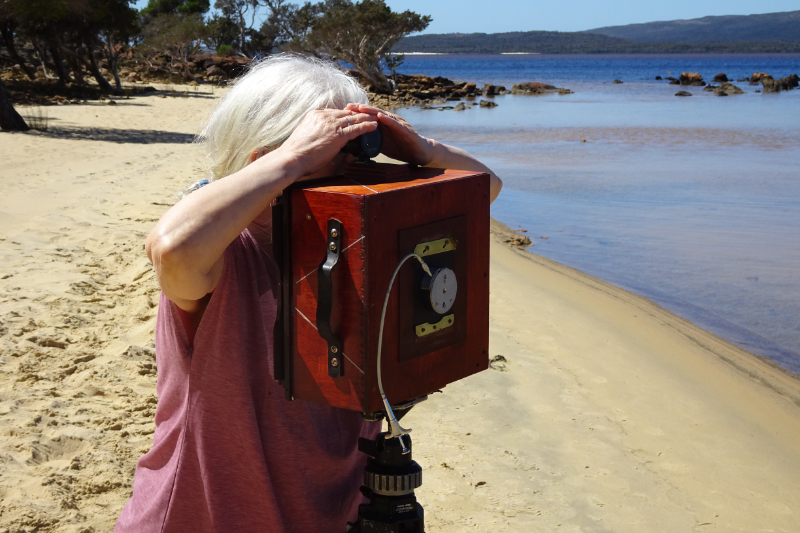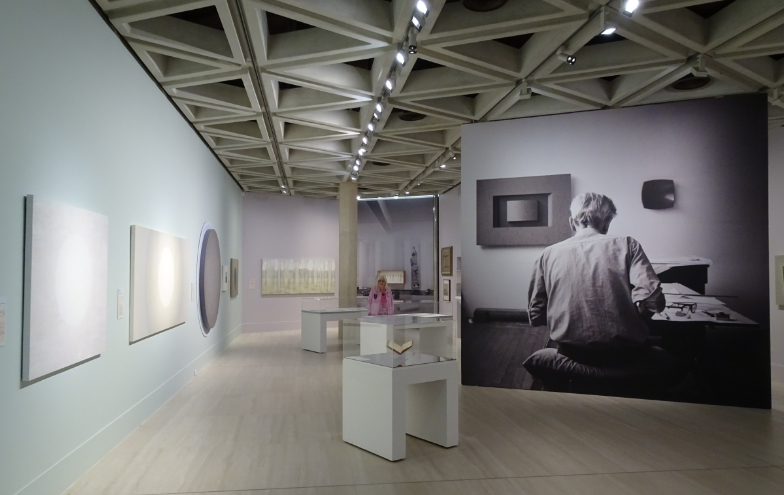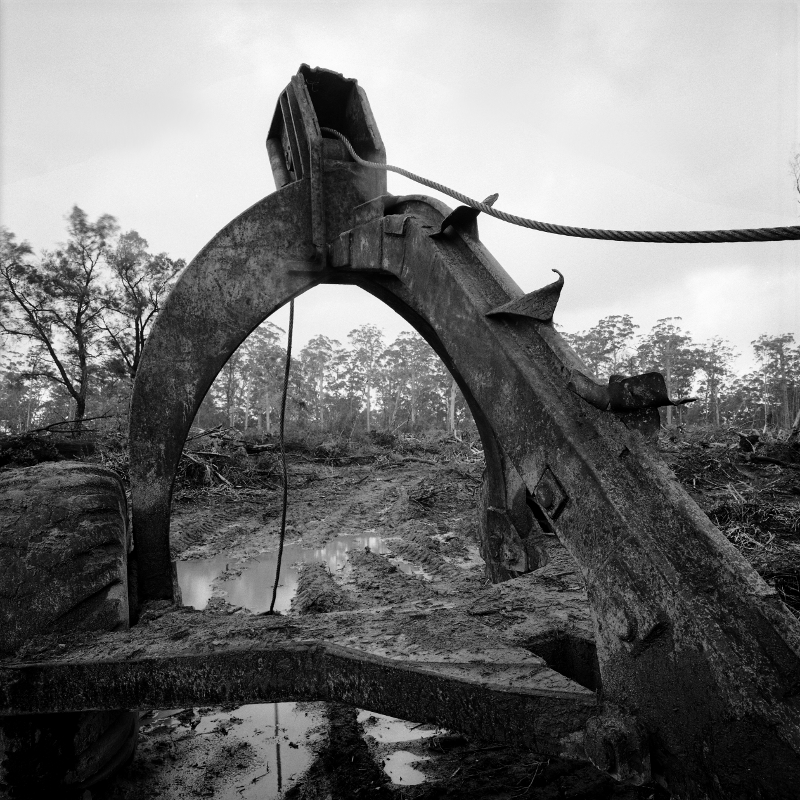Photographic Printmaking
May 5th, 2020 • Tech Notes • Uncategorised
Written in the time of Covid19
In this age of digital wonders, I continue to work with film cameras and make silver gelatine prints in a real darkroom.
Wet print of Karara Swamp WA 2004 on splash board above fixer tray
This post is about my photographic printmaking, but first I will mention the importance of balance, that there has to be a balance between the subject and its representation. A bad print of an amazing subject does not reveal and a beautiful print of boredom is a nice gray scale. However, this is the subject of another post, so I will leave it for now.
In my work appropriate print quality is important. By appropriate printing I include my often contrasty images from the early 1970s. (I still have the catalogue for the Hawyard Gallery Bill Brandt Retrospective.)
The harsh prints of 1980s Perth new music movement see Artists Portraits.
Lindsay Vickery, Leighton Beach, Perth, WA 1989
More recently the over enlarged grainy prints of the late 1990s forest protest actions in the Southern Forest Region of Western Australia see Karri Forest III – Protest and Conflict.
Penny's Dragon forest protest, Wattle Forest, WA 1998
Apart from these situations I normally use large format cameras and the finest prints I can make from their negatives.
At the beginning of a new body of work I have often worked with the Zone System to achieve easily printable negatives. I would subsequently simplify my location practice for speed and concentration on the light and subject. The Zone system is often understood as a way of making fine long toned prints of Californian landscapes, but it is far more fluid and broad than that. Good prints don’t have to show the full suite of mid tones to for the print to be right for the subject, and the Zone System can help with that too.
Bum, Abysinia Rocks WA 1992
However, apart from the 35mm portfolios mentioned above, and experimental bodies of work, my preference for almost all of my personal work is for sharp, richly toned prints from large negatives.
Burnt Forest, Quinninup, WA 2000
Karri Forest, Boorara, WA 2000
On a personal level I enjoy good silver jelly prints. I also enjoy the process; a day in the darkroom, followed the next morning taking the prints from the drying rack and viewing them in good light. Some prints get torn up, or marked up for reprinting, but that is another story. I also enjoy charcoal drawing and etching, but I no longer have an etching press.
Foam, Fernhook Falls, Deep River, WA 2009
The importance of the rightness of a chosen medium in Modernist practice was beautifully described by Brett Whitely in his introduction to the catalogue of his printmaking; the parallels to photographic printmaking are clear.
Brancusi in sculpture & Mattise (Sic) in graphics were the two artists that particularly made one aware of respecting the integrity and truth of each medium whether it be marble, cedar, lithography charcoal etc; that a pen behaves so differently from a brush, that to draw on copper with a fine nail suits certain subjects, that to draw with a greasy crayon on stone is perfect for others, the nude for example. I am not interested in the Marxist side of printmaking - cheaper originals. A good print should have the same feeling of ‘rightness’ that a one-off drawing should have.
Scan of Brett Whiteley catalogue
But equally an artist can use any technique or combinations of techniques, any paper, any photo reproduction method he chooses, in fact anything he thinks fits the image he is after . . . But Brancusi and Mattise (Sic) knew that for openers.
Brett Whitely
Graphics 1961 – 1982
Pub. Art Gallery of Western Australia, 1983
Image cropping
I will deal with this quickly. Cropping a photographic image is forbidden. No argument, this is fact.
The reasons are that cropping shows poor seeing or poor camera management. If I refuse to crop I am forced to give attention to framing and particularly what is happening at the edges of the frame. I never crop 35mm or 120, and print the edge of the enlarger frame. With Hasselblad negatives this gives a black line at the edge of the print, with Rolleiflex negatives the image meets the edges of the neg' holder.
For 5x4", which I find to be an awkward format, neither square nor rectangular, I frame on the 9x12cm frame line in Linhof and Sinar ground glass screens. This planned "cropping" gives me the 3:4 ratio I prefer, also this is the standard motion picture format. Framing to the 9x12cm format looses dark slide and processing hanger marks. But thse machine artifacts can look good in a 10x8" contact print.
Photographic printmaking darkroom
My photographic printmaking technique is really simple. I have four enlargers, DeVere DVF5108E and DVB504 for 10x8” and 5x4” or for large prints from smaller negatives. The 5108 has a set of Rodagons, but I generally use a 240mm Apo-Geronar for 10x8” negatives to 20x24” prints, now my largest size. There is no need for the 300mm enlarging lens as even for 30x40” prints a 240mm lens is extended to over 30cm, so there is lens coverage to spare and I can reach the controls without standing on a crate, or dropping the baseboard, which makes my back ache by the end of the day. The DVB504 has a set of Schneider Componons and a 150mm G-Claron.
Darkroom enlargers
For small prints, to 12” square from 120 negatives and 10x15” from 35mm I use Leitz Focomat IIc and Ic enlargers with Ilford Multigrade heads. These are very simple to operate and set the contrast grade, but I almost never need to go outside grades two to three contrast range. The Leitz Ic for 35mm has been fitted with a Rodenstock Apo-Rodagon and the auto-focus cam has been set to work with this lens through its entire range. Resetting a Focomat auto-focus cam for a new lens is easy within narrow limits and takes only a few moments. I have tried a Schneider Comonon S 50mm lens on the Focomat Ic, but it is outside the cam’s adjustment range.
The Focomat IIc has a new 35mm glassless carrier and a 6x6cm glassless bottom frame for Rollei negatives, less glass equals less dust, but 120 needs a top glass for absolute flatness. These accessories for the IIc are from Kienzle Phototechnik, Wildberg, Germany.
When working professionally I used good cameras and lenses, but I no longer have M series Leicas and I have also sold all my Hasselblads. For 35mm I use Nikon F or 1940s Leicas. For LF I still have my Voigtlander and Schneider lenses from 1924 to 1980s However, I do not compromise on darkroom equipment. This are the best that can be obtained. The logic being that whatever the quality of the negative is it is filtered through the enlarger lens, if these are poor quality the money spent on Cooke, Leitz, Nikon, Schneder or Zeiss camera lenses is wasted.
Photographic printmaking materials
The means and materials referred to here are not new, or unique to me. They are standard procedures from the 1970s, but fifty years on they could do with being restated.
I use two paper types, Fomabrom Variant glossy and Foma Variant Warm Tone. The choice of Foma paper from Bohemia is based on the fact it is regularly imported into Australia and is readily available. My previous papers of choice were Ilford Galerie for the Littoral Portfolios and Agfa Record Rapid for other subjects. I mourn the loss of these two papers deeply. The soft dove-grey print colour of the Ilford was perfect for the cool light of the coast, and the deep warm tonal resonance of the Agfa RR was great for deserts, forests and prints of peiple. But I am learning to work with the Foma, and the warm tone Foma has a rich tonality, although not when compared with a Record Rapid print. However, like with film, the best results are obtained by getting to know how paper responds. I do not use resin coated paper.
Vintage prints or new interpretations?
There was, and possibly still is, a claim that "vintage prints" have a truer value than ones made years after. Vintage prints are prints made at about the time an image was photographed. This vintage print idea has no basis other than gallery and agent price gouging. I find that the time that passes before an image is printed allows me to distance myself from the memory of the photographic event and enables me to assess the negatives made with greater distance and clarity, also my printing is constantly improving. The new prints and interpretations are the best.
Prints are developed in Ilford ID20 MQ developer and sometimes Dr Beers as a two bath developer for some awkward negatives. Dr Beers is basically a split MQ developer that can be used mixed.
Stop bath is 2% acetic acid, I am tempted to use lemon juice as we have a huge lemon tree feeding from the septic systemn, I have not tried this yet, but the lemons are well flavoured.
There is a photographer and friend who claims that an acid stop bath is bad as it adds acid to the print. But to me this is silly as the fixer is acid and the acid is in any case neutralised by the alkali in the selenium toner and the hypo clearing agent.
Fixing is in Ilford IF-2 as a two bath fixer, two minutes in each bath. When exhausted, the first fixer bath is put in a Silver Magnet electrolytic silver reclamation unit. I am collecting a jar of crumbly metallic silver, but I am not sure what to do with it. On the good side, it is not being released to the environment.
Occasionally I will brighten the contrast in deep shadows with almost hidden highlights with potassium ferricyanide in extremely dilute solution. If used with care ferricyanide increases contrast of the shaded highlights without visibly reducing the depth of the blacks.
I selenium tone for black intensification, as in the New Zone System Manual, White, Zakia and Lorenz, pub Morgan & Morgan NY 1976, Appendix K, but at 10% KRST.
Hypo clearing is in Agfa 320 with 1% of Sodium sulphite added. Print washing is tested with silver nitrate solution in acetic acid on a test strip taken through the whole process for this porpoise. My prints are of archival quality as I see no point making prints on good paper and not finishing them properly.
A printing map of burning and dodging, with notes on exposure time, aperture, edition numbers and other details are recorded in my photo journal. These notes are important.
Alternative processes
I help Rae Starr with lith negatives and with the darkroom aspects of her alternative process work with cyanotype, but I have no interest in alternative printmaking methods for myself, except perhpas platinum. Photogravure has attracted me, and my non-photo printmaking background in etching draws me there as well, but time and no etching press means I will continue with silver jelly for as long as I can.
Digital printing
Firstly, I do not refute the huge value of digital photography in many ares and in particular its value of for reportage and scientific use.
There is a current practice to use film cameras for photography followed by scanning the negatives for digital printing or other use. Apart from scanning a silver negative for email or a website I feel this is a silly way to work, loosing the benefits of both.
Regarding digital printing, when compared to silver jelly a black and white digital print, even the best "Art" print from the 42” Epson large format machine is a flat and boring thing. I thought this was my opinion, but the digital print tonal range can be measured and compared with a reflection densitometer.
Vewiing scans of photographs on computer screens
On a final practical note, and despite my best efforts, attempts to make the image scans in this website look good when transferred to a computer screen fail miserably. They lose all the depth and subtlety I strive to achieve in the silver gelatine originals. The only way to view a black and white film based original is as a fine silver jelly print.
← Return to Blog





 RSS Feed
RSS Feed